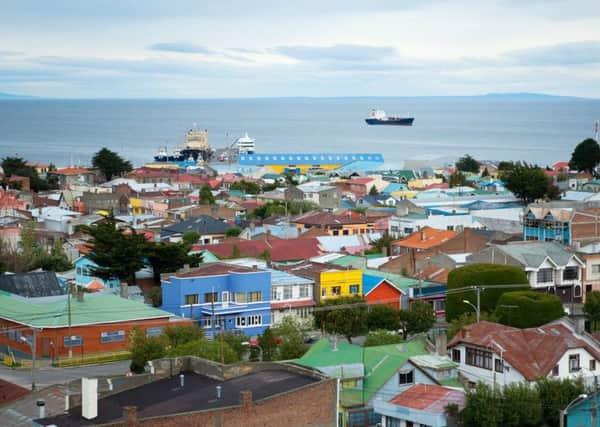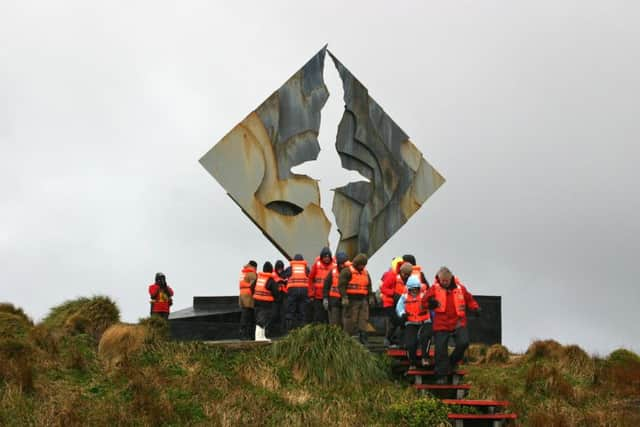Travel: The solitary beauty of Patagonia


Dear Guests, it is 6:15am, the temperature outside is 10 degrees, skies are overcast and we are now navigating the Southern Ocean Passage. Coffee is being served in the Sky Lounge and we will shortly be arriving at Cape Horn.”
For a holiday wake-up call, this early morning announcement couldn’t have been more thrilling. I was on a four-day cruise around Patagonia on the Chilean expedition ship Stella Australis and all 129 passengers were eagerly awaiting the dawn zodiac landings at Cape Horn. Outside on the deck, however, the normally cheerful group of baby boomer hikers stood ashen faced with fear as a howling wind buffeted the ship. Below us the zodiacs (rigid inflatable boats) were tossing up and down on the steel grey ocean while plumes of spray shot up from gigantic waves. We’d been warned that there was only a 50/50 chance that conditions would be favourable enough for zodiac landings, and as we clambered down the stairway to the boarding platform, many of us were secretly hoping for a last-minute cancellation. Boarding a zodiac is normally a graceful three-step movement during which a crew member gently holds your arm as you step on to the boat. On this occasion, however, they were taking no chances and gripping our upper arms tightly, three crew members hoisted us on to the rocking boat and unceremoniously dumped us into position. With a jerk the zodiac plunged into the heaving waves and we all bent forwards as spray showered our backs, only occasionally daring to look up at the foreboding cliffs of Cape Horn.
Advertisement
Hide AdA journey to Patagonia conjures up images of ice-bound mountains, penguin colonies and hardy sheep farmers. The few towns that exist in this most southerly inhabited corner of the world you’d expect to be scruffy fishing ports, so it came as a big surprise to arrive in Punta Arenas and discover a buzzing, cosmopolitan city, the equal of any in South America. The city’s prosperity was built on sheep farming, gold prospecting and most recently oil. Around the beautiful shady central Plaza Muñoz Gamero, graceful mansions with ornate porticos and balconies add an almost Parisian elegance to the city centre, but a reminder of the harsh elements is all too evident. Patagonia is famous for its storm force winds and outside the Hotel Plaza, a rope lines the street to protect unsuspecting shoppers from being blown under passing buses.


Punta Arenas is a great place to spend a couple of days recovering from the long flight, but it is Patagonia’s majestic scenery and wildlife that most visitors come to see. A good introduction is to head south from Punta Arenas to the beautiful Park of the Strait of Magellan where a state-of-the art visitor centre explores the complex history, geography and wildlife of the region.
As Patagonia gears up to commemorate the 500th anniversary of the discovery of the Strait of Magellan in 2020, Randy Twyman, the park’s director, is keen to put the event into a wider historical context. As he explained, Patagonia was inhabited for 8,000 years by four tribes whose own story of endurance and discovery is every bit as remarkable as the great European adventurers. Equipped with basic canoes, they migrated down the Americas and, in one of the world’s most hostile environments, carved out a successful nomadic life harvesting shellfish and hunting guanacos, a relative of the camel.
Their story ended in tragedy when Chile opened up Patagonia to sheep farmers in the late 19th century. Finding sheep far easier to hunt than guanacos, the indigenous tribes soon came into conflict with the rich estancia owners who began employing violent foremen to exterminate them. The Selk’nan tribe of Tierra del Fuego suffered the most and the last member died in the 1930s. On the walls of the visitor centre is a collection of haunting photographs taken by Martin Gusinde, a German priest who in the 1900s foresaw their demise.
These were the original Patagonians, the people with “big feet” whose towering stature once amazed the diminutive Spanish explorers. Covered in striped body paint and wearing strange conical hats their proud expressions bear witness to a heartbreaking genocide that the world has largely forgotten.


The Strait of Magellan cuts across the southern tip of South America in a 600km S shape, to the south of which lies a splintered mass of fjords and islands. Unless you are an experienced sailor with time on your hands, the only feasible way of visiting this remote region is on a cruise. For travellers wary of cruising, Australis’ four day Fjords of Tierra del Fuego trip dispenses with formality and offers casual, action-packed itineraries with daily zodiac excursions led by enthusiastic local guides.
Advertisement
Hide AdOur first port of call was Ainsworth Bay which lies deep in the heart of the Alberto de Agostini National Park where the retreating Marinelli Glacier has left a pristine wilderness of indigenous vegetation rich in birdlife. As if on cue, the moment our zodiac landed on a wild boulder-strewn beach, a pair of condors appeared and began gracefully circling above our heads. The zodiac excursions offer various levels of hiking and the difficult one took us scampering up a hillside along a treacherously slippery stream. It was early autumn and the ground was covered in glistening purple calafate and red chaura berries. The calafate, a species of berberis, tastes like an earthy blueberry and its juice is a popular cocktail ingredient in Chile. The chaura resembles a miniature apple and has a similar refreshing tart taste. Up on the hillside, the views of the Marinelli Glacier spilling over the mountain tops were spellbinding. As we returned to the ship the capricious weather filled the bay with sheets of rain intermingled with shafts of sunlight forming miniature rainbows that the zodiacs chased across the water. That afternoon as the Stella Australis passed through the narrow Gabriel Channel we were treated to the exhilarating sight of sea lions frolicking in the water accompanied by a majestic juvenile hump backed whale.
Back on Horn Island the zodiac rammed into the landing bridge and, with audible sighs of relief, we jumped ashore. There we were greeted by José, Cape Horn’s smiling lighthouse keeper, who was dressed in an immaculate naval uniform. Some 160 steps lead up the cliffs to a windswept plateau and a hauntingly beautiful sculpture of an albatross, the Cape Horn Memorial, which gazes out over the Southern Ocean. Nearby, a moving poem written by Chilean author Sara Vial commemorates the thousands of mariners who over the centuries lost their lives sailing around the Cape.
Advertisement
Hide AdOn my last night on board there was a knock on my cabin door and a smiling cabin boy handed me an envelope. Intrigued, I opened it and pulled out a certificate with a map of Patagonia emblazoned with a delightful penguin stamp. It was a “diploma” confirming that I had set foot on Cape Horn. I was thrilled; few travel experiences give you as much satisfaction as visiting this iconic geographical landmark and the certificate is a memento I’ll always treasure.
• Journey Latin America, the UK’s No 1 specialist in travel to Latin America, offers a 10-day holiday to Patagonia from £3,720pp. The trip includes two nights in Punta Arenas, three nights on board the Stella Australis, and three nights in Torres del Paine National Park. Flights, transfers, most meals and excursions are also included. Contact Journey Latin America (020 8600 1881, www.journeylatinamerica.co.uk); www.patagonia-chile.com